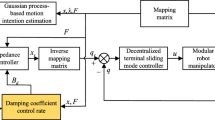Abstract
In this paper, adaptive dynamic coupling control is considered for hybrid joints, which could be switched to either active (actuated) or passive (under-actuated) mode, for human-symbiotic wheeled mobile manipulators with unmodelled dynamics. This social robot can be used in the house, the office, etc, which can flexibly interact with the human and would not injure the people. The constraints for such social robots consist of kinematic constraints and dynamic constraints. Based on Lyapunov synthesis, adaptive coupling control using physical properties of mobile social robot is proposed for passive hybrid joints, which ensures that the system outputs track the given bounded reference signals within a small neighborhood of zero, and guarantee semi-global uniform boundedness of all closed loop signals. The effectiveness of the proposed controls is verified through extensive simulations.
Similar content being viewed by others
References
Stirling WC, Nokleby MS (2009) Satisficing coordination and social welfare for robotic societies. Int J Soc Robot 1(1):53–69
Bartneck C, Kulic DD, Croft E, Zoghbi S (2009) Measurement instruments for the anthropomorphism, animacy, likeability, perceived intelligence, and perceived safety of robots. Int J Soc Robot 1(1):71–81
Li Z, Ming A, Xi N, Gu J, Shimojo M (2005) Development of hybrid joints for the complaint arm of human-symbiotic mobile manipulator. Int J Robot Autom 20(4):260–270
Takubo T, Arai H, Tanie K (2002) Control of mobile manipulator using a virtual impedance wall. In: Proceedings of IEEE international conference on robotics and automation, pp 3571–3576
Lin S, Goldenberg AA (2001) Neural-network control of mobile manipulators. IEEE Trans Neural Netw 12(5):1121–1133
Dong W (2002) On trajectory and force tracking control of constrained mobile manipulators with parameter uncertainty. Automatica 38:1475–1484
Li Z, Ge SS, Ming A (2007) Adaptive robust motion/force control of holonomic-constrained nonholonomic mobile manipulators. IEEE Trans Syst Man Cybern, Part B, Cybern 37(3):607–617
Brooks R, Aryanada L, Edsinger A, Fitzpatrick P, Kemp CC, O’Reilly U, Torres-jara E, Varshavskaya P, Weber J (2004) Sensing and manipulating built-for-human environments. Int J Humanoid Robot 1(1):1–28
Spong MW (1995) The swing up control problem for the acrobot. IEEE Control Syst 15:49–55
Zhang M, Tarn T (2002) Hybrid control of the pendubot. IEEE/ASME Trans Mechatron 7(1):79–86
Ge SS, Wang J, Lee TH, Zhou GY (2001) Adaptive robust stabilization of dynamic nonholonomic chained systems. J Robot Syst 18(3):119–133
Ge SS, Wang Z, Lee TH (2003) Adaptive stabilization of uncertain nonholonomic systems by state and output feedback. Automatica 39(8):1451–1460
De Luca A, Oriolo G (2002) Trajectory planning and control for planar robots with passive last joint. Int J Robot Res 21(5–6):575–590
Bergerman M, Lee C, Xu Y (1995) A dynamic coupling index for underactuated manipulators. J Robot Syst 12(10):693–707
Isidori A, Marconi L, Serrani A (2003) Robust autonomous guidance: an internal model approach. Springer, New York
Tinos R, Terra MH, Ishihara JY (2006) Motion and force control of cooperative robotic manipulators with passive joints. IEEE Trans Control Syst Technol 14(4):725–734
Ertugrul M, Kaynak O, Kerestecioglu F (2000) Gain adaptation in sliding mode control of robotic manipulators. Int J Syst Sci 31(9):1099–1106
Alwi H, Edwards C (2008) Detection and fault-tolerant control of a civil aircraft using a sliding-mode-based scheme fault. IEEE Trans Control Syst Technol 16(3):499–510
Ge SS, Hang CC, Lee TH, Zhang T (2002) Stable adaptive neural network control. Kluwer Academic, Boston
Su C, Stepanenko Y (1994) Robust motion/force control of mechanical systems with classical nonholonimic constraints. IEEE Trans Autom Control 39(3):609–614
Ge SS, Lee TH, Harris CJ (1998) Adaptive neural network control of robot manipulators. World Scientific, London
Wang ZP, Ge SS, Lee TH (2004) Robust motion/force control of uncertain holonomic/nonholonomic mechanical systems. IEEE/ASME Trans Mechatron 9(1):118–123
Chang YC, Chen BS (2000) Robust tracking designs for both holonomic and nonholonomic constrained mechanical systems: adaptive fuzzy approach. IEEE Trans Fuzzy Syst 8:46–66
Ge SS, Zhang J (2003) Neural-network control of nonaffine nonlinear system with zero dynamics by state and output feedback. IEEE Trans Neural Netw 14(4):900–918
Hahn W (1967) Stability of motion. Springer, New York
Author information
Authors and Affiliations
Corresponding author
Additional information
This work is supported by Shanghai Pujiang Program under grant No. 08PJ1407000 and Natural Science Foundation of China under Grant Nos. 60804003 and 60935001, and New Faculty Foundation under Grant No. 200802481003.
Rights and permissions
About this article
Cite this article
Li, Z., Yang, Y. & Wang, S. Adaptive Dynamic Coupling Control of Hybrid Joints of Human-Symbiotic Wheeled Mobile Manipulators with Unmodelled Dynamics. Int J of Soc Robotics 2, 109–120 (2010). https://doi.org/10.1007/s12369-010-0049-8
Accepted:
Published:
Issue Date:
DOI: https://doi.org/10.1007/s12369-010-0049-8




